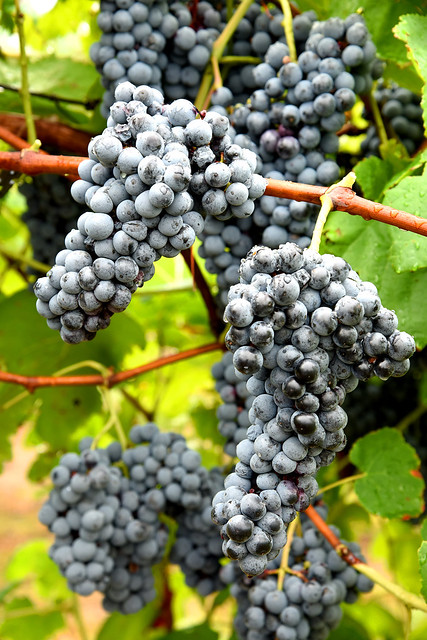Nov. 10, 2016
Div of Ag’s first wine grapes can stand up to Arkansas conditions, diseases
By Fred Miller
U of A System Division of Agriculture
Fast Facts:
- Division of Agriculture releases first two wine grapes from breeding program
- Enchantment is a red wine grape with deep, rich color
- Opportunity is a versatile white wine grape that can produce a range of flavors
(641 words)
(Newsrooms: With Related VIDEOS
Opportunity:
https://www.youtube.com/watch?v=_jSYLpsjIcY
Enchantment:
https://www.youtube.com/watch?v=z7iukIV4C68,
With art at www.flickr.com/photos/uacescomm/albums/72157672699605683)
FAYETTEVILLE, Ark. — The first wine grapes from the University of Arkansas System Division of Agriculture fruit breeding program expand options for grape growers and wine makers in Arkansas and neighboring states.
Opportunity, a white wine grape, and Enchantment, a red wine grape, have shown good adaptation and consistent productivity in Arkansas, said John R. Clark, Distinguished Professor of horticulture and director of the division’s fruit breeding program.

Clark and Renee Threlfall, research scientist in food science, introduced the new grapes to the Arkansas Association of Grape Growers during their annual conference in Ozark last Friday.
Some of the wine makers in the group have had early samplings of the grapes to test in their vineyards.
Keith Striegler, grower outreach specialist for E&J Gallo Winery, said he expects Opportunity is going to replace Cayuga, a New York grape that is one of the most common white wine grapes in the eastern U.S.
“It has all the good wine making features of Cayuga,” Striegler said, “without the problems associated with growing it.”
He said Enchantment also will make a fine wine grape.
A number of grape growers in the meeting said they were testing Enchantment or Opportunity in their vineyards, including Post Familie of Altus and Sassafras Springs Winery of Springdale.
Wendy Quaid of An Enchanting Evening Winery near Little Rock said she wants to grow Enchantment just for the sake of the name. Enchantment wine from An Enchanting Evening Winery is “twice as enchanting,” she
said.
Clark said he and James N. Moore, Distinguished Professor Emeritus and founder of the Arkansas fruit breeding program, made the initial selections in 1991 for Opportunity and 1993 for Enchantment. Wines were made and tested from these by Justin Morris, Distinguished Professor Emeritus and Threlfall.
Opportunity originated from a cross of Cayuga, a New York variety, and a selection from Semillion and Rkatsiteli, Clark said. This combination gives the white wine grape good adaptation to Arkansas growing conditions and results in a high quality grape.
Opportunity matures around the fourth week of August, Clark said. In 20 years of close observation, downy mildew was rarely seen and powdery mildew appeared only twice, suggesting some resistance to these two diseases.
Enchantment has a unique combination of genetics from multiple species, Clark said. The female parent was a cross of Petit Syrah and Alicante Bouschet, and the male parent was a cross of Bouschet Petit and Salvador. Salvador, he said, includes the grape species Vitis lincecumii and Vitis rupestris.
Enchantment also matures around the third week of August. Like Opportunity, it seems to have the same potential resistance to common diseases, with only a light downy mildew infection in one year out of 18 and powdery mildew appearing only twice.
Clark said fungicide sprays should still be used because of other potential diseases and because of typically rainy weather during the growing season in Arkansas.
The chemical makeup of both grapes results in excellent wines, Clark said.
Threlfall said Opportunity is a flexible grape that can make wines with fruit forward flavors ranging from sweet to dry. “It has a wonderful, balanced finish,” she said.
Enchantment is a teinturier grape, Threlfall said, which gives it its rich, dark color.
Typically, red wine grapes get their color from anthocyanin pigments extracted from their crushed skins during fermentation. Teinturier grapes have anthocyanin pigments in their flesh and juice, Threlfall said, allowing wine makers to extract rich, dark colors.
“Enchantment is a very versatile wine grape,” Threlfall said. “The wine can be made into a rosé or a blush. It can be dry. Its flavor can be fruity or oaky.”
Clark noted that Enchantment’s unique pigmentation also makes it ideal for use as a blending wine.
Enchantment and Opportunity are patented and will be licensed to domestic nurseries, Clark said. Vines should be available in a limited number beginning this winter.
Pursuant to 7 CFR § 15.3, the University of Arkansas System Division of Agriculture offers all its Extension and Research programs and services (including employment) without regard to race, color, sex, national origin, religion, age, disability, marital or veteran status, genetic information, sexual preference, pregnancy or any other legally protected status, and is an equal opportunity institution.
# # #
Media Contact: Mary Hightower
Dir. of Communication Services
U of A Division of Agriculture
Cooperative Extension Service
(501) 671-2126
mhightower@uada.edu